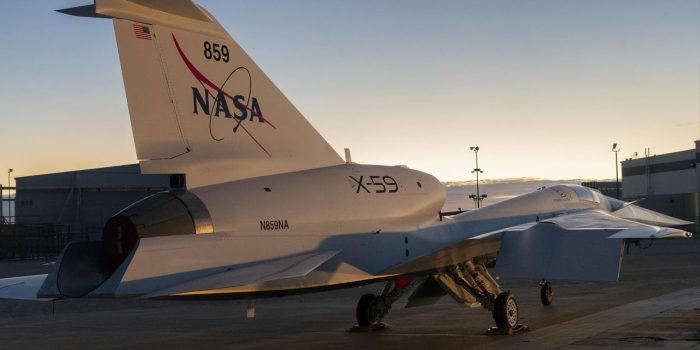In the ongoing effort to transform aviation, NASA and Lockheed Martin have introduced the X-59 quiet supersonic aircraft, which is a major step forward. Lockheed Martin Skunk Works in Palmdale, California hosted the reveal, which was witnessed by NASA Deputy Administrator Pam Melroy and other high-ranking officials.
NASA’s Quesst project, which attempts to gather information that might lead to a reexamination of regulations banning commercial supersonic flying over land, heavily relies on the X-59. Such flights have been prohibited for decades because of the upsetting sonic booms they cause in the nearby villages.

Flying at 1.4 times the speed of sound (925 mph), the X-59 is intended to produce a more subdued sonic boom, thereby mitigating one of the primary barriers to supersonic travel over densely populated regions. NASA Headquarters’ assistant administrator for aeronautics research, Bob Pearce, was enthusiastic about the potential advantages of the Quesst mission and emphasized NASA’s commitment to sharing the technology and data produced with industry and regulatory bodies.
After completing the rollout, the Quesst team will proceed to integrated systems testing, engine runs, and taxi testing before the X-59’s anticipated first flight later this year. The initial flight will be followed by the first quiet supersonic flight, with flight tests conducted at Skunk Works before transferring the aircraft to NASA’s Armstrong Flight Research Center in Edwards, California.

The unique design of the X-59, measuring 99.7 feet long and 29.5 feet wide, incorporates innovative technologies to enable quiet supersonic flight. The aircraft’s thin, tapered nose, constituting almost a third of its length, helps break up shock waves that would typically result in a sonic boom. The cockpit, located almost halfway down the length of the aircraft, lacks a forward-facing window, utilizing the eXternal Vision System with high-resolution cameras and a 4K monitor.
Lockheed Martin Skunk Works’ Vice President and General Manager, John Clark, expressed honor in contributing to the development of this groundbreaking aircraft, emphasizing the collaborative effort of dedicated scientists, engineers, and production artisans across both teams. Once flight tests are completed, NASA plans to gather public input on the X-59’s sound perception during flights over selected U.S. cities, providing valuable data to aviation authorities worldwide. The X-59 represents a leap forward in supersonic travel, demonstrating the feasibility of quiet commercial flights over land and opening new possibilities for the aviation industry.


